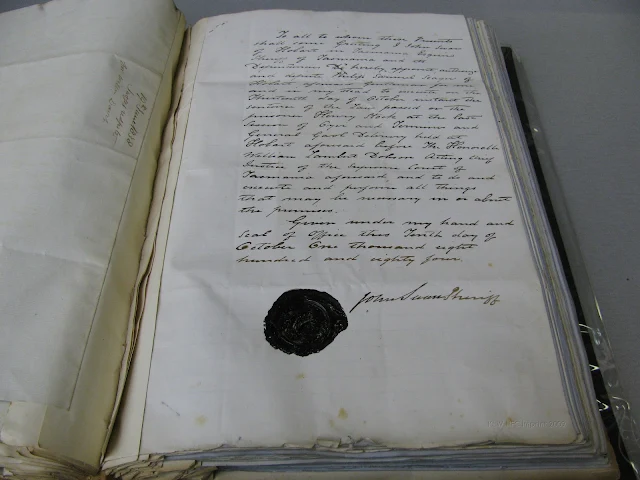NEVIN brothers Thomas and John Nevin, police photographers
MISATTRIBUTION and fake history, the NLA and PAHSMA.
During the fourteen years of contractual work with the Hobart City Corporation, the Lands and Survey Department, and the Hobart Municipal Police Office (1872-1886) at the Hobart Town Hall, commercial photographer and civil servant Thomas J. Nevin deployed the conventional techniques of 19th century commercial studio portraiture in matters of posing, photographing and printing the final official prisoner identification photograph (mugshot) in an oval mount. Seated in front of a plain backcloth, sometimes dark, sometimes light, only the upper torso of the prisoner was photographed, his sightlines deflected 45 degrees to the edge of the frame. The majority - but not all - of Thomas J. Nevin's prisoner photographs taken from 1872 into the 1880s which are held at the Queen Victoria Museum and Art Gallery (QVMAG); the Tasmanian Museum and Art Gallery (TMAG); the Penitentiary Chapel, Hobart; the Port Arthur Heritage Site, and the National Library of Australia (NLA) evince his use of this commercial technique, evident as well in these two photographs of prisoners James Mullins and William Smith taken in 1875 which are held in the Mitchell Collection, State Library of NSW:
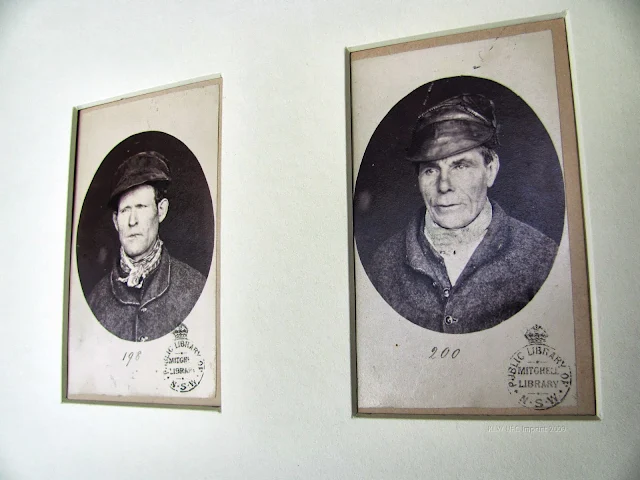
Above: The two photographs of prisoners, James Mullins on left and William Smith on right, which bear T. J. Nevin's colonial Royal warrant studio stamp used on all Hobart Supreme Court documents.
Tasmanian prisoners James Mullins and William Smith
Taken by T. J. Nevin, Hobart Gaol, 1875
Source: Mitchell Library SLNSW (PXB 274)
Photos copyright © KLW NFC 2009-2010
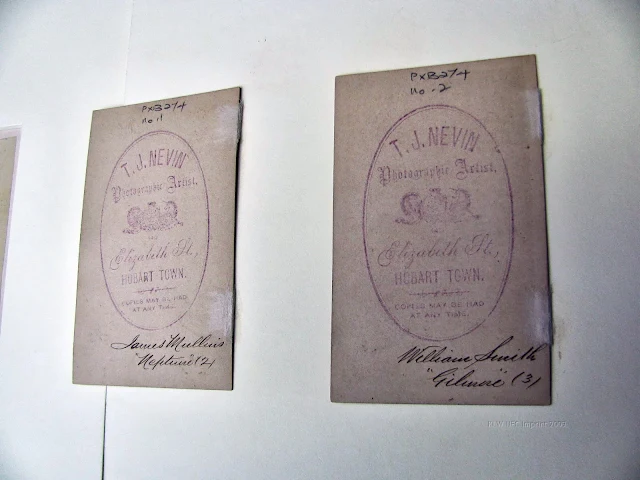
Verso: Tasmanian prisoners James Mullins and William Smith
T. J. Nevin, government contractor studio stamp Hobart Gaol, 1875
Source: Mitchell Library SLNSW (PXB 274)
Photos copyright © KLW NFC 2009-2010
Neither cdv bears a date, but the photographs can be dated from the week in July 1875 when both men were booked and arrested. James Mullins' cdv (on left) is numbered recto "198" and William Smith's (on right) is numbered recto "200". Thomas Nevin took an earlier and different photograph of an unshaven Smith, which is numbered "199" and which also bears his government contractor Royal colonial warrant studio stamp. It is held at the Queen Victoria Museum and Art Gallery. See this article here on this site.
POLICE RECORDS James Mullins and William Smith

William Smith, photo on right (above), was photographed on arrest by T. J. Nevin at the Hobart Gaol on 9th July 1875.

Source: Tasmania Reports of Crime Information for Police, James Barnard Gov't Printer
James Mullins, photo on left (above), was photographed on arrest by T. J. Nevin at the Hobart Gaol 13th July 1875.
Regulations per amendments to the Police Acts of Victoria and Tasmania 1872 required Thomas Nevin to provide several duplicates in carte-de-visite format from the one image of the prisoner he recorded on the glass negative. One duplicate was pasted to the criminal's record sheet; another was held in the Sheriff's Office at the Hobart Gaol; several more were circulated to regional police stations, prisons (including Port Arthur) and depots, and another was held at the Town Hall Municipal Police Office central registry (as supplements to the police gazettes called the Photo Books) where they were sometimes displayed in a Rogues' Gallery along the walls. Thomas Nevin also displayed photographs of absconders and others wanted on warrant in his studio shop window at 140 Elizabeth Street, Hobart Town while still operating as a commercial photographer. Some of the prints he (or his assistants) hand-tinted to reflect reality: blue for blue eyes and blue for the prison issue scarves. Physical descriptions of wanted criminals which were written by Edwin Midwood, the Information Officer at the Municipal Police Office and printed in the weekly Police Gazettes (titled Tasmania Reports of Crime Information for Police) took pains to list the colour of the wanted man's eyes, hair, whiskers, complexion, and clothing.
Thomas J. Nevin's younger brother Constable John Nevin (William John, and Jack to the family) joined the civil service in 1870 at the Cascades Prison for Males, and by 1876 he was armed and resident at H. M. Gaol, Hobart acting as Thomas Nevin's photographic assistant, eventually executing duties as the photographer and messenger there until his untimely death from typhoid in 1891. Between 1876 and 1886, transitional years in the history of 19th century prison photography, changes took place in the way Thomas Nevin posed the prisoner and printed the final mugshot. The technology changed too. Lenses after 1875 enabled a closer or larger image of the face. The prisoner was also posed closer to the camera in a full frontal position facing the photographer, and although the oval mount was still the preferred format for printing, square frames were also used. The formalised front and profile pair of portraits using the methods of Bertillonage did not appear in Tasmanian prison photography until the late 1890s, by which time Thomas Nevin had ceased professional photography and his younger brother John Nevin was deceased.
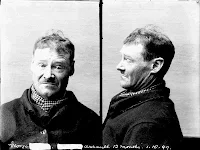
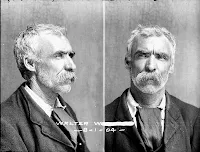
Above: Bertillon method: front and profile pair
Tasmanian prisoner mugshots, 1897 and 1904
Source: Tasmanian Museum and Art Gallery
FULL FRONTAL POSE
This photograph (below) of Constable John Nevin was taken by his brother Thomas J. Nevin ca. 1880 and probably in situ at the Hobart Gaol or Supreme Court. It was printed on a mount with a square blue outer border.

Constable John Nevin, younger brother of photographer Thomas Nevin, ca. 1880
Copyright © KLW NFC Imprint 2009 Private Collection
Three prisoner photographs in this group of Tasmanian prisoners by Thomas J. Nevin held in the David Scott Mitchell Collection (Mitchell Library SLNSW PXB 274) were printed with the same square border, coloured sepia in the same tint as the oval frame:
Tasmanian prisoners Michael Parker and William Henry Butler
Photos by T. J. Nevin , 1877-1878
Taken at the Hobart Gaol, Campbell St. Hobart.
SLNSW PXB 274
Prisoner William Henry Butler, taken at the Hobart Gaol.
Verso inscription: William Henry Butler, "St. Vincent"
Photo by T. J. Nevin , 1877-1878
Mitchell Library SLNSW (PXB 274)
Photo copyright © KLW NFC 2010
Prisoner Michael Parker, taken at the Hobart Gaol.
Photo by T. J. Nevin , 1877-1878
Mitchell Library SLNSW (PXB 274)
Photos copyright © KLW NFC 2010
The booking photograph Thomas Nevin took of Patrick Lamb (below) on 10th February 1876 also has a square outer border, not common on these prisoner mugshots. Patrick Lamb, free to colony (FC) on the Siam, was booked and sentenced on 10th February 1876 to three (3) years in the Hobart Gaol for wounding with intent. The photograph was duplicated again by Constable John Nevin at the Hobart Gaol when Patrick Lamb was discharged from the Supreme Court on 15th May, 1878. The full frontal position marks the transition phase in Thomas Nevin's portraiture in the years 1876-86, from the aesthetics of the conventional commercial portrait to the mugshot, in which the eyes are open and the gaze is direct to camera, a requirement in the interests of the police administration, and no doubt dictated by a belief in the realism of photography.
Tasmanian prisoner Patrick Lamb per Siam, taken at the Hobart Gaol
Photo by T. J. Nevin , 1877-1878
Mitchell Library SLNSW (PXB 274)
Photos copyright © KLW NFC 2010 ARR
POLICE RECORDS Patrick Lamb

Source: Tasmania Reports of Crime Information for Police, James Barnard Gov't Printer
Patrick Lamb was photographed by Thomas Nevin at the Hobart Supreme Court on Lamb's arraignment, 10th February 1876. Nevin would have been more than a little interested in proceedings since fellow photographer Stephen Spurling was also arraigned in the same session for obtaining credit under false pretences, released on bail. None of the Spurling family of photographers was ever employed as a police or prisons photographer in Tasmania, should propinquity alone suggest otherwise.

Source: Tasmania Reports of Crime Information for Police, James Barnard Gov't Printer
Tasmanian prisoner Patrick Lamb per Siam, taken at the Hobart Gaol
Photo by T. J. Nevin , 1877-1878
Mitchell Library SLNSW (PXB 274)
Photos copyright © KLW NFC 2010 ARR
Patrick Lamb was discharged from Hobart on 11th May 1878. His prisoner identification photograph was reprinted at that time by Nevin for circulation to police in the region where Lamb would seek employment.
THE PARASITIC ATTRIBUTION
As with all of these mugshots in this group of nine bequeathed by David Scott Mitchell to the State Library Of NSW ca 1907, there is no verso inscription which mentions "Port Arthur", unlike several other photographs of Tasmanian prisoners taken by Thomas Nevin, held at the NLA and the QVMAG, which were incorrectly inscribed on verso "Taken at Port Arthur 1874" by an early 20th century archivist (and copyists for the tourist trade), and which subsequently led to misattribution of these prisoner mugshots to the non-photographer Port Arthur accountant A.H. Boyd (Long 1995 et al). The effect of the misattribution can be seen in the catalogue entry to this collection too, despite the absence of any wording on the versos of the photographs themselves relating to Port Arthur.

In August 2009, the catalogue entry was revised and A. H. Boyd's name removed, per this webshot:

The two photographs in this group of nine bear Nevin's government contractor stamp incorporating the Royal Arms colonial warrant, the same insignia which appears on the seal of the Supreme Court of Tasmania, yet the original record entry proposed extraordinary contradictory logic: that the stamped cdv's are "copies of originals made by A.H. Boyd." This statement is nonsense; it has no basis in fact. Whereas photo-historians make an attribution to a photographer if his studio stamp appears on the mount or verso of the photograph, the perversity here is the modalised atrribution of Nevin's work to the non-photographer A.H. Boyd, despite Nevin's stamp. As with any other government contractor, Nevin was required to register copyright with ONE trade example of a photograph per batches of hundreds, and if passed, copyright endured for 14 years. Once employed as a full-time civil servant with the Hobart City Council, his use of a nominal stamp was unnecessary. This lack of knowledge of patent registration by photographers contributed to researchers' (eg. Chris Long) serious errors in deflecting Nevin's attribution in 1995. Long has since pleaded ignorance of the facts, but his cohort has closed ranks around him in a pretence of support while bleeding the error for all its worth. See the latest attempt at the NLA's full record online catalogue for their 83 holdings of Nevin's mugshots, which references A. H. Boyd. The record until 2007 was headed with Nevin's name; since then the deeply aspirational, sycophantic and opportunistic Julia Clark has talked her way into Nevin's life (and ours, which is her point) with a student "essay" purporting to be research about Boyd that borders on abuse of moral rights of Nevin and his descendants, and for what? The promotion of this particular prison official Boyd as an "ARTIST"????? Or self-promotion by Clark, hoping to call herself one day Dr Clark? Her foolishness is narcissistic and not without pathos, her methods fraudulent, and her motives political. See this article A Question of Stupidity and the NLA.
The association of the non-photographer A.H. Boyd with T. J. Nevin's name is a PARASITIC ATTRIBUTION. It derives principally from a chain of references by late 1990s commentators (Long, Reeder, Ennis, Crombie) to a sentence in an unpublished children's fictional tale about a school holiday at Port Arthur written in the 1930s by a niece of Boyd - a tale which does NOT mention Boyd by name, nor does it mention the photographing of prisoners. Chris Long (TMAG 1995) founded his belief in Boyd on this piece of fiction, created a "darkroom" and photographic paraphernalia as Boyd's and coupled it with the assertion that the Port Arthur prison official A. H. Boyd not only ordered equipment to take photographs of prisoners (as a sort of amateur one-off ethnographic portfolio), he photographed them himself, despite the fact A. H. Boyd was never known to be a photographer in his own life-time, and there are NO works in existence in any genre that can be accredited to A. H. Boyd. The extant 300 prisoner mugshots taken in the mid 1870s are nothing more than random estrays of hundreds more prisoners photographed by the Nevin brothers for use by police: they each depict men who were habitual offenders and recidivists whose repeat offences earned them a further sentence and a mugshot by Nevin on incarceration, and over a decade from 1872 to 1886. A. H. Boyd left the position of Commandant at Port Arthur in December 1873, forced to resign over allegations of corruption, and played no role in the colonial government's photographic documentation of prisoners convicted in the Supreme Court during the 1870s .
Tasmanian prisoners photographed at the Hobart Gaol
Photos by T. J. Nevin , 1877-1878
Mitchell Library SLNSW (PXB 274)
Photos copyright © KLW NFC 2009 ARR
RELATED POSTS main weblog





